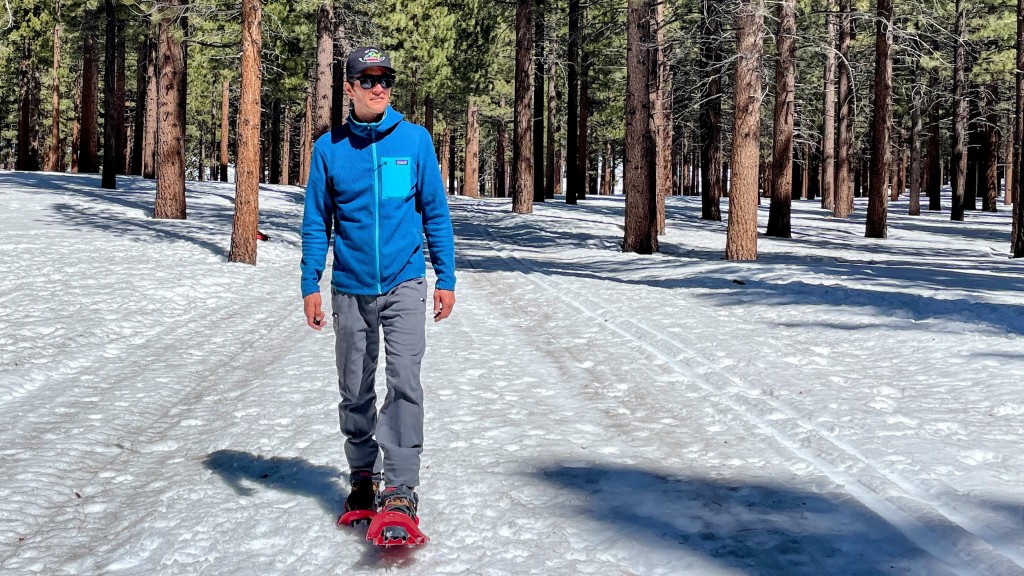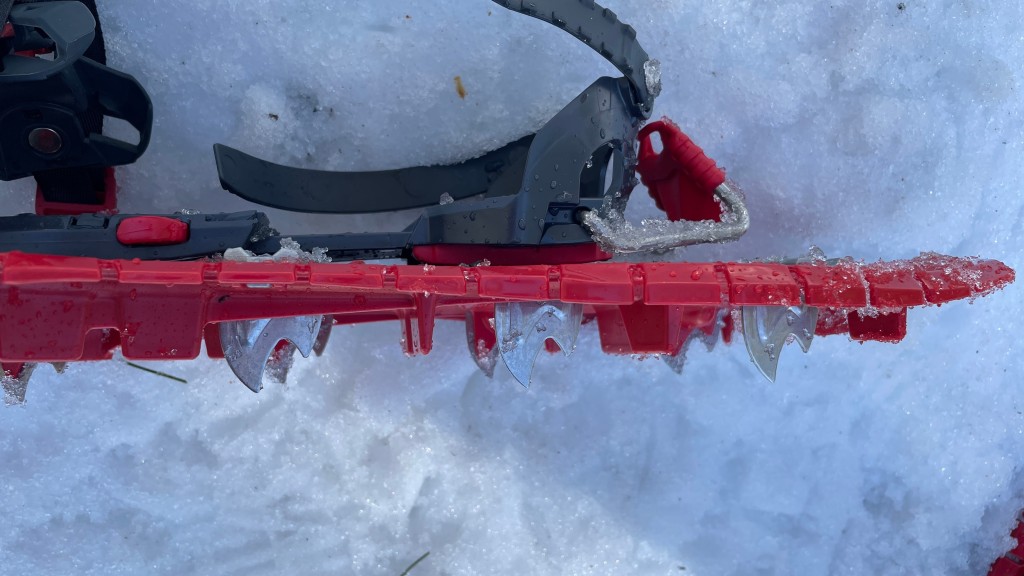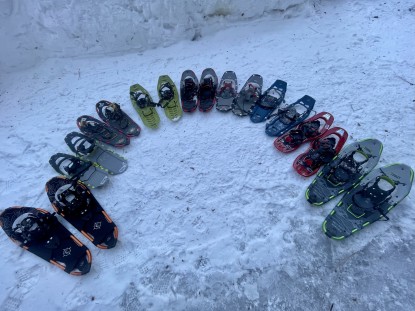Our Verdict
Compare to Similar Products
 This Product
TSL Symbioz Hyperflex Elite | |||||
|---|---|---|---|---|---|
| Awards | Best for Trails | Best Overall Snowshoes | High Performance Affordability | Best for Fresh Deep Snow | Best on A Tight Budget |
| Price | $300 List $289.95 at Backcountry | $389.95 at REI Compare at 4 sellers | $169.95 at REI Compare at 3 sellers | $220 List $219.95 at Amazon | Check Price at Amazon |
Overall Score  |
|||||
| Star Rating | |||||
| Bottom Line | A good choice for firm, hard packed snow when you don't need a ton of float | Our overall champ combines simplicity and high-quality materials, features, and engineering | This reliable and well-priced snowshoe is versatile and easy to use | A good choice for off trail travel and softer snow | Most cheap snowshoes have poor bindings, but we found the G2 to be comfy and secure |
| Rating Categories | TSL Symbioz Hyperfl... | MSR Lightning Ascent | MSR Evo Trail | Crescent Moon Big S... | G2 Ratchet Binding |
| Flotation (30%) | |||||
| Traction (30%) | |||||
| Walkability (20%) | |||||
| Bindings (20%) | |||||
| Specs | TSL Symbioz Hyperfl... | MSR Lightning Ascent | MSR Evo Trail | Crescent Moon Big S... | G2 Ratchet Binding |
| Measured Weight (per pair) | 4.6 lbs | 4.0 lbs | 3.7 lbs | 5.1 lbs | 4.5 lbs |
| Sizes Available | 20.5" (S), 23.5" (M), 27" (L) | 22", 25", 30" | 22" (one size) | 32" (one size) | 22", 25", 30", 36" |
| Binding System | Combination of rigid plastic, nylon straps, cam locks, and ratchet style straps | Rubber net and straps with pin-in-hole | Rubber net and straps with pin-in-hole | Rubber straps with plastic buckles | Ratchet straps with plastic buckles, EVA padding, rubber tension straps |
| Frame Material | Composite | Aluminum | Plastic and steel | Aluminum | Aluminum |
| Measured Surface Area | 162 sq in | 188 sq in | 183 sq in | 256 sq in | 225 sq in |
| Measured Dimensions | 22"L x 8"W | 25"L x 8"W | 24"L x 8"W | 32"L x 10"W | 31"L x 9"W |
| Binding/Deck Connection | Hinged | Hinged | Hinged | Strapped | Hinged |
| Crampon/Traction Aids | Steel crampons and teeth | Steel crampons, rails, and teeth | Steel crampons and rails | Steel crampons | Aluminum crampons and teeth |
| Deck Material | Composite | TPU coated Nylon | Polypropylene | Polyurethane fabric | Polyethylene fabric |
| Heel Lift | Yes | Yes | No | Optional | Yes |
| Flotation Tails Sold Separately? | No | Yes | Yes | No | No |
| Men's and Women's Versions? | Unisex | Yes | Unisex | Yes | Unisex |
| Optimum Weight Load (per manufacturer) | 65-180 lbs (size S) 110-260 lbs (size M) 150-300 lbs (size L) |
up to 180 lbs (size 22") 120-220 lbs (size 25") 150-280 lbs (size 30") |
up to 180 lbs | up to 225 lbs | up to 150 lbs (size 21") up to 200 lbs (size 25") up to 250 lbs (size 30") up to 300 lbs (size 36") |
| Tested Size | M | 25" | 22" | 32" | 30" |
Our Analysis and Test Results
Every once in a while, a product surprises us. When it comes to snowshoes, our decades of experience have given us a good handle on the market and let us develop strong preferences. For trail-oriented shoes, we look for a compact size for easy striding, good spikes for packed-snow traction, and a frame joined to the binding with soft decking and straps for shock absorption. The TSL Symbioz Elite, however, breaks our thoughts asunder and delivers a product that accomplishes excellent trail performance with a different suite of features. They are indeed compact with excellent traction, but the unorthodox deck and binding construction surprised us.
Performance Comparison
Flotation
Surface area (which we measure in square inches) is the main way that a snowshoe provides flotation, its primary job. The Symbioz Elite are the smallest snowshoes in our entire test by far. This is one very shapely snowshoe, so right out of the box, we didn't expect great flotation performance. It tapers at the tip and tail and in the middle. Because the surface area is less, one's weight isn't spread evenly over the entire surface area. Further, the longitudinally flexible frame and deck limit the flotation capability.
The flotation performance we experienced in the Symbioz Elite is by far the worst of any snowshoes in our entire review. These are not designed for deep snow and off-trail use; any other product will be better. Characteristics that lend a model performance in that area generally detract from walking performance on the trail or in a denser, melt-freeze springtime snowpack — things the Elite does excel at.
Traction
Snow is slippery, and traction is one of the important benefits we get from strapping on a pair of snowshoes. The Symbioz Elite sports metal spikes on the bottom of the deck for traction, and they are downright frightening. They are the sharpest in our test and are spread over the entire snowshoe bottom. Each of the six spikes is an individual, deep triangle of steel. The result is excellent traction. Keep them away from your puffy jacket.
The traction aids also include cleats on the binding and paddles and ridges molded into the plastic of the deck. The flexibility of the deck kept the Symbioz from the very top of the chart in this metric. We think this is because the lack of rigidity occasionally made it tricky to transfer force from our feet to the spikes.
Walkability
As noted above, it is the stride ergonomics that truly sets the Symbioz Elite apart. Normally a hinged binding does not lend itself to smooth walking. For walking on firm snow and trails, our testers prefer a strapped attachment as this lends some comfort in the form of shock absorption. In this case, the hinged binding is precise, and the shock absorption comes from the very flexible deck.
This unique combination means that you won't do better than this contender on the packed snow of traveled or groomed trails. This pair has the most natural stride in those settings. The compact size is unobtrusive, and the curvy shape (a liability for flotation) lends itself to an almost normal stride. We found we could walk more comfortably and efficiently on trails in the Symbioz than any other snowshoe in our test.
Bindings
Once the bindings are set up, they are among the easiest to get on and off. That initial setup is more complicated than the others, and if you switch boots periodically, you will likely need to make these setup adjustments again. The included instruction manual is mildly helpful. We recommend doing this at home instead of at the trailhead right before you head out.
For routine use with the same pair of footwear, on and off is very easy and simple. Two steps get you in or out of the ratcheting strap system. Levers on the buckle make adding tension much less strenuous than pulling hard on a rubber strap. Releasing tension to remove the snowshoe is equally easy. The main drawback is that the bindings are bulky, which cost it some points in this metric. The Symbioz cannot nest against one another, and this bulk is noticeable when packing in a car or a checked bag.
The binding of this pair of snowshoes is unlike any other in the test. It is somewhat more complicated, with straps and cam-locks that take some initial setup. The end result, though, is a system that spreads the force of retention over the user's entire foot, even in the softest of shoes. Our testers really appreciated the padding that's designed for smooth and comfortable walking. These are comfortable with almost any footwear.
We had absolutely no problems with the security of the Symbioz Elite bindings. In miles of use, they never moved, much less came off. To make bindings that are this secure and this comfortable is a tall order. The cost is just a little setup time for each new pair of boots or user. Once configured, the binding snaps right on. That said, there is a minor potential for some binding icing. Bindings that are designed around rubber straps may be slightly more secure and certainly pack more compactly, but the tension of the stretched rubber straps can compromise circulation and create pressure points.
Should You Buy the TSL Symbioz Elite?
Our snowshoe selection is mostly all-around models. The Symbioz Elite is a more specialized product, and we think it's the right choice for hikers who want snowshoes for a specific use. In this case, that means predominantly groomed or well-traveled trails. They can be pressed into service for other purposes, especially slippery snow, but they're best on trails.
The Symbioz Elite is an innovative product that takes a gamble on some unorthodox construction attributes and design cues. Taking chances like that often backfires, and a solution is proffered for a problem that doesn't actually exist. In this case, however, we have been pleasantly surprised with the niche and performance of the Symbioz Elite. For hikers who know that they're looking for a comfortable snowshoe with great traction that's easy to walk in and don't care about flotation, this is the model.
What Other Snowshoes Should You Consider?
Hikers who are looking for a snowshoe that's pleasing to walk in but a little more versatile have several options. The Tubbs Panoramic has decent traction, easy-to-use bindings, and a hybrid hinged/strapped deck-to-binding connection that provides good stride ergonomics under a variety of conditions. Also worth consideration is the MSR Evo Trail. While not as flexible as the Symbioz Elite the deck is also short, which makes this hinged model pleasant to walk in. Both of these alternatives have larger decks and so more flotation than the Symbioz.















